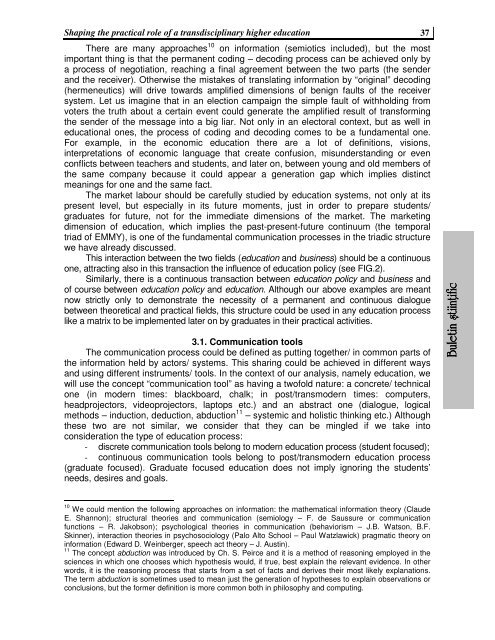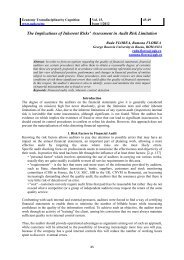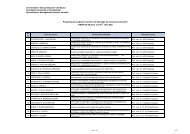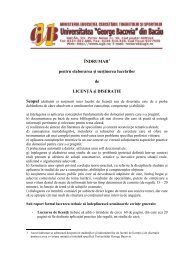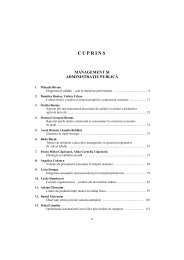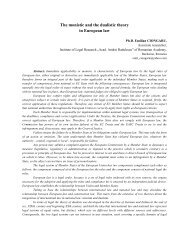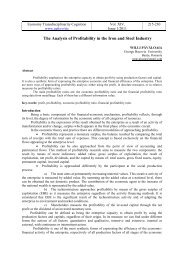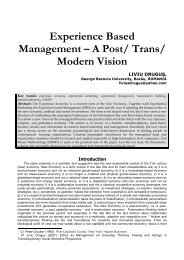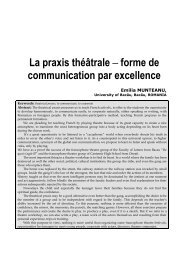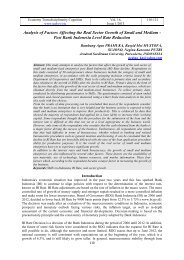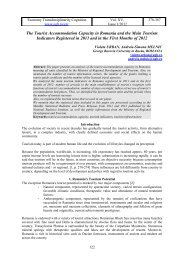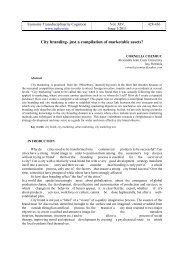BULETIN ÄTIIN IFIC - Universitatea George Bacovia
BULETIN ÄTIIN IFIC - Universitatea George Bacovia
BULETIN ÄTIIN IFIC - Universitatea George Bacovia
You also want an ePaper? Increase the reach of your titles
YUMPU automatically turns print PDFs into web optimized ePapers that Google loves.
Shaping the practical role of a transdisciplinary higher education 37<br />
There are many approaches 10 on information (semiotics included), but the most<br />
important thing is that the permanent coding – decoding process can be achieved only by<br />
a process of negotiation, reaching a final agreement between the two parts (the sender<br />
and the receiver). Otherwise the mistakes of translating information by “original” decoding<br />
(hermeneutics) will drive towards amplified dimensions of benign faults of the receiver<br />
system. Let us imagine that in an election campaign the simple fault of withholding from<br />
voters the truth about a certain event could generate the amplified result of transforming<br />
the sender of the message into a big liar. Not only in an electoral context, but as well in<br />
educational ones, the process of coding and decoding comes to be a fundamental one.<br />
For example, in the economic education there are a lot of definitions, visions,<br />
interpretations of economic language that create confusion, misunderstanding or even<br />
conflicts between teachers and students, and later on, between young and old members of<br />
the same company because it could appear a generation gap which implies distinct<br />
meanings for one and the same fact.<br />
The market labour should be carefully studied by education systems, not only at its<br />
present level, but especially in its future moments, just in order to prepare students/<br />
graduates for future, not for the immediate dimensions of the market. The marketing<br />
dimension of education, which implies the past-present-future continuum (the temporal<br />
triad of EMMY), is one of the fundamental communication processes in the triadic structure<br />
we have already discussed.<br />
This interaction between the two fields (education and business) should be a continuous<br />
one, attracting also in this transaction the influence of education policy (see FIG.2).<br />
Similarly, there is a continuous transaction between education policy and business and<br />
of course between education policy and education. Although our above examples are meant<br />
now strictly only to demonstrate the necessity of a permanent and continuous dialogue<br />
between theoretical and practical fields, this structure could be used in any education process<br />
like a matrix to be implemented later on by graduates in their practical activities.<br />
3.1. Communication tools<br />
The communication process could be defined as putting together/ in common parts of<br />
the information held by actors/ systems. This sharing could be achieved in different ways<br />
and using different instruments/ tools. In the context of our analysis, namely education, we<br />
will use the concept “communication tool” as having a twofold nature: a concrete/ technical<br />
one (in modern times: blackboard, chalk; in post/transmodern times: computers,<br />
headprojectors, videoprojectors, laptops etc.) and an abstract one (dialogue, logical<br />
methods – induction, deduction, abduction 11 – systemic and holistic thinking etc.) Although<br />
these two are not similar, we consider that they can be mingled if we take into<br />
consideration the type of education process:<br />
- discrete communication tools belong to modern education process (student focused);<br />
- continuous communication tools belong to post/transmodern education process<br />
(graduate focused). Graduate focused education does not imply ignoring the students’<br />
needs, desires and goals.<br />
<br />
<br />
<br />
10 We could mention the following approaches on information: the mathematical information theory (Claude<br />
E. Shannon); structural theories and communication (semiology – F. de Saussure or communication<br />
functions – R. Jakobson); psychological theories in communication (behaviorism – J.B. Watson, B.F.<br />
Skinner), interaction theories in psychosociology (Palo Alto School – Paul Watzlawick) pragmatic theory on<br />
information (Edward D. Weinberger, speech act theory – J. Austin).<br />
11 The concept abduction was introduced by Ch. S. Peirce and it is a method of reasoning employed in the<br />
sciences in which one chooses which hypothesis would, if true, best explain the relevant evidence. In other<br />
words, it is the reasoning process that starts from a set of facts and derives their most likely explanations.<br />
The term abduction is sometimes used to mean just the generation of hypotheses to explain observations or<br />
conclusions, but the former definition is more common both in philosophy and computing.


